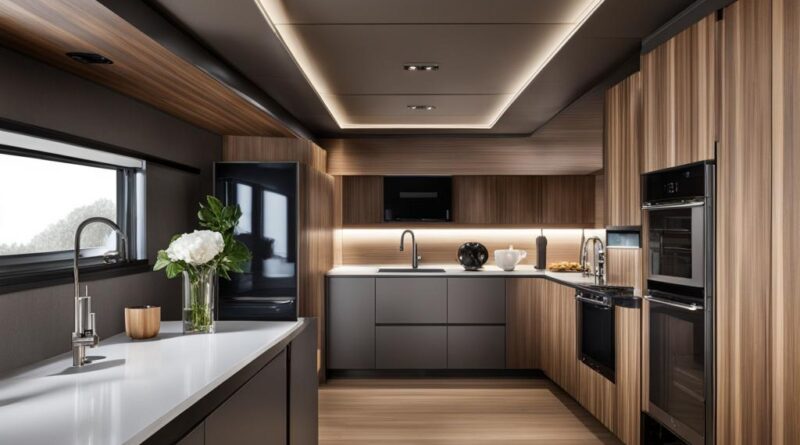Mobile Home Ceiling Panels: Best Choices & Tips
When it comes to mobile home interiors, the ceiling is often overlooked. However, choosing the right ceiling panels can make a significant difference in the overall look and feel of your mobile home. In this article, we will explore the best choices and valuable tips for mobile home ceiling panels.
Most mobile homes have ceilings made of gypsum panels. These panels are affordable and lightweight, making them a popular choice for mobile home construction. While gypsum panels are easy to install and come in various sizes and thicknesses, they can have a slightly textured surface that some homeowners may not prefer. Additionally, older gypsum panels can be delicate, prone to sagging or becoming unattached, and may turn yellow over time.
Key Takeaways:
- Mobile home ceilings are typically made of gypsum panels, which are affordable and lightweight.
- Gypsum panels can have a slightly textured surface and may turn yellow over time.
- These panels come in various sizes and thicknesses, making them easy to install and replace.
- Older gypsum panels can be delicate and prone to sagging or becoming unattached.
- Consider alternative materials such as insulated panels or sheetrock for ceiling replacements.
Advantages of Mobile Home Gypsum Ceiling Panels
Gypsum ceiling panels offer several advantages for mobile homes. Here are some key benefits:
- Affordability: Mobile home gypsum ceiling panels are a cost-effective option for homeowners who want to improve the look of their mobile homes without breaking the bank.
- Lightweight: These panels are lightweight, making them easy to handle and install, even for DIY enthusiasts. Their lightweight nature also reduces the risk of overburdening the mobile home’s structure.
- Easy Replacement and Repair: If a gypsum ceiling panel gets damaged or needs to be replaced, it can be easily done without causing extensive disruption or expense. This is particularly advantageous for mobile homeowners who may encounter occasional maintenance issues.
- Design Choices: Mobile homeowners can choose from a variety of designs and sizes when it comes to gypsum ceiling panels. Whether they want a smooth finish or a textured look, there are options available to suit their personal tastes and preferences.
Gypsum ceiling panels provide an affordable, lightweight, and customizable solution for mobile homes. Their ease of installation and repair make them an attractive choice for homeowners looking to improve their mobile home interiors.
“Gypsum ceiling panels provide an affordable, lightweight, and customizable solution for mobile homes.”
Different Designs of Mobile Home Gypsum Ceiling Panels
Mobile home gypsum ceiling panels offer a range of designs to enhance the aesthetics of your interior space. Whether you prefer a classic or contemporary look, there are various options to choose from. Let’s explore some popular designs:
Rosette and Trim Design
One common design utilizes 4-foot wide panels adorned with beautiful rosettes and a plastic trim to cover the seams. This design adds a touch of elegance and sophistication to your mobile home ceiling. The rosettes act as decorative accents, while the trim helps conceal any visible joints for a seamless finish.
Beaded Profile or Spline Design
Another popular option is the beaded profile or spline design. In this design, beaded profiles or splines are used to cover the seams between the gypsum ceiling panels. The beaded profiles or splines create a visually appealing pattern and add depth to the ceiling, enhancing its overall beauty.
Channeled Ceiling Dividers and Integrated Strips
For a more contemporary look, you can opt for channeled ceiling dividers and integrated strips. These elements are designed to create clean lines and modern appeal in your mobile home. The channeled dividers provide a structured and symmetrical appearance, while the integrated strips offer a seamless transition between panels.
Customized Designs with Dimensional or False Beams
For those seeking a unique and personalized touch, customized designs with dimensional or false beams can add character to your mobile home ceiling. These designs create the illusion of beams, adding architectural interest and creating a warm, inviting atmosphere. The dimensional or false beams can be customized to match your desired style and complement the overall interior design of your mobile home.
Consider the different designs available and choose the one that best suits your personal taste and complements the overall aesthetics of your mobile home.
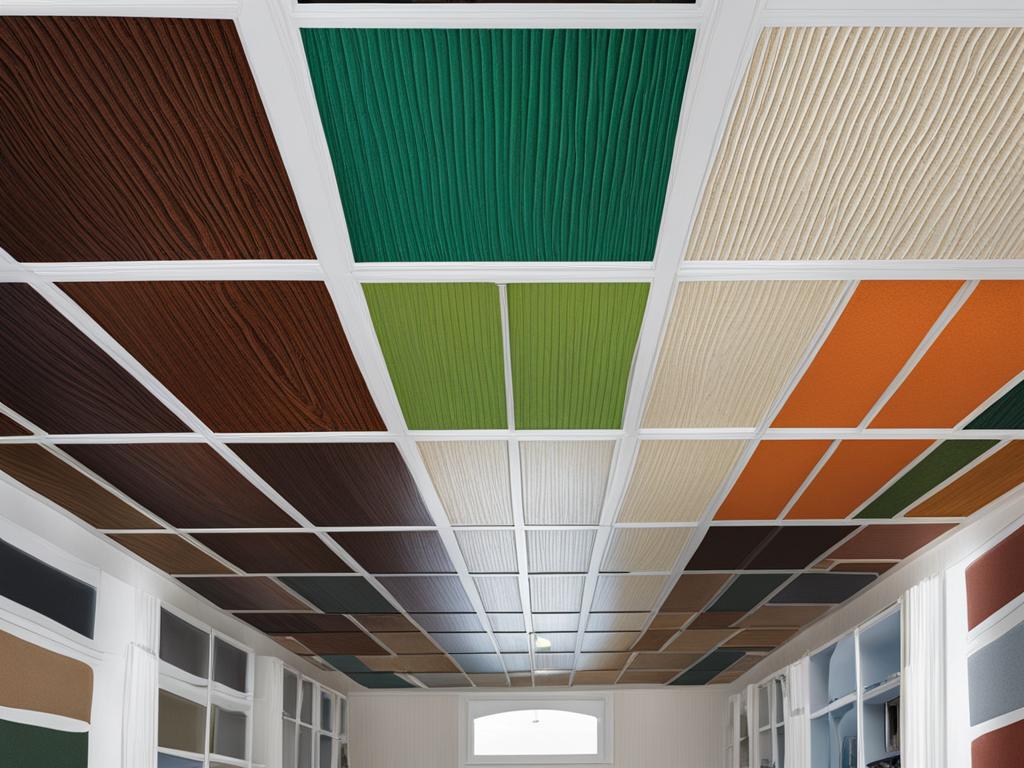
Explore the visual representation of different mobile home gypsum ceiling panel designs:
| Rosette and Trim Design | Beaded Profile or Spline Design | Channeled Ceiling Dividers and Integrated Strips | Customized Designs with Dimensional or False Beams |
|---|---|---|---|
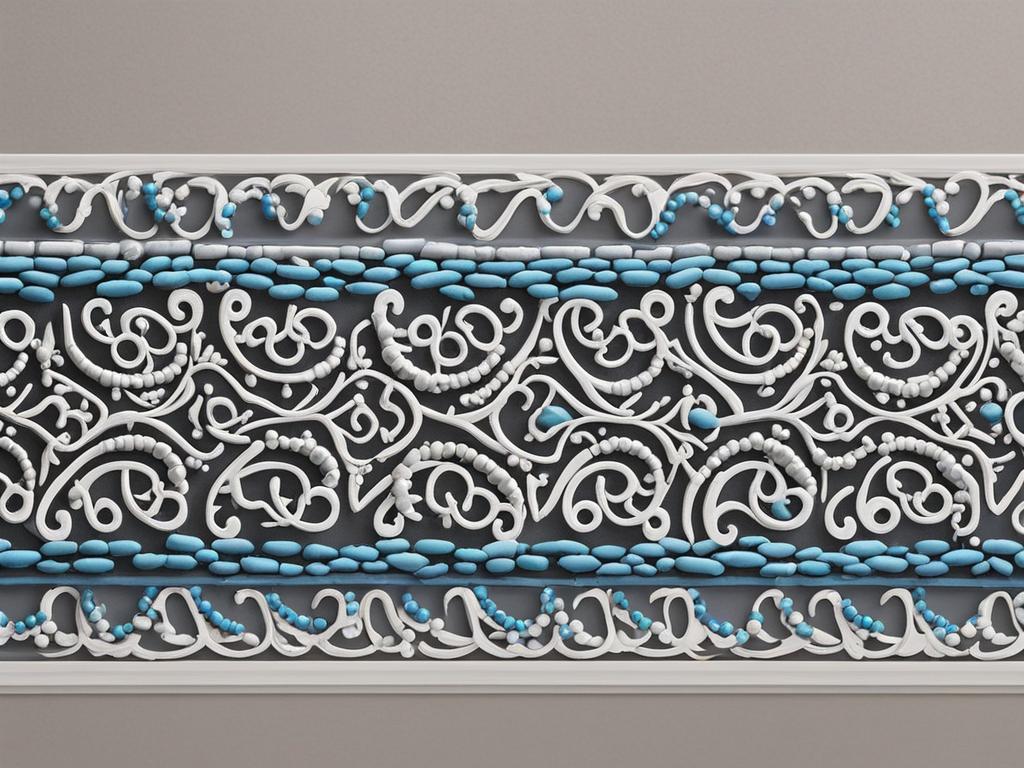 |
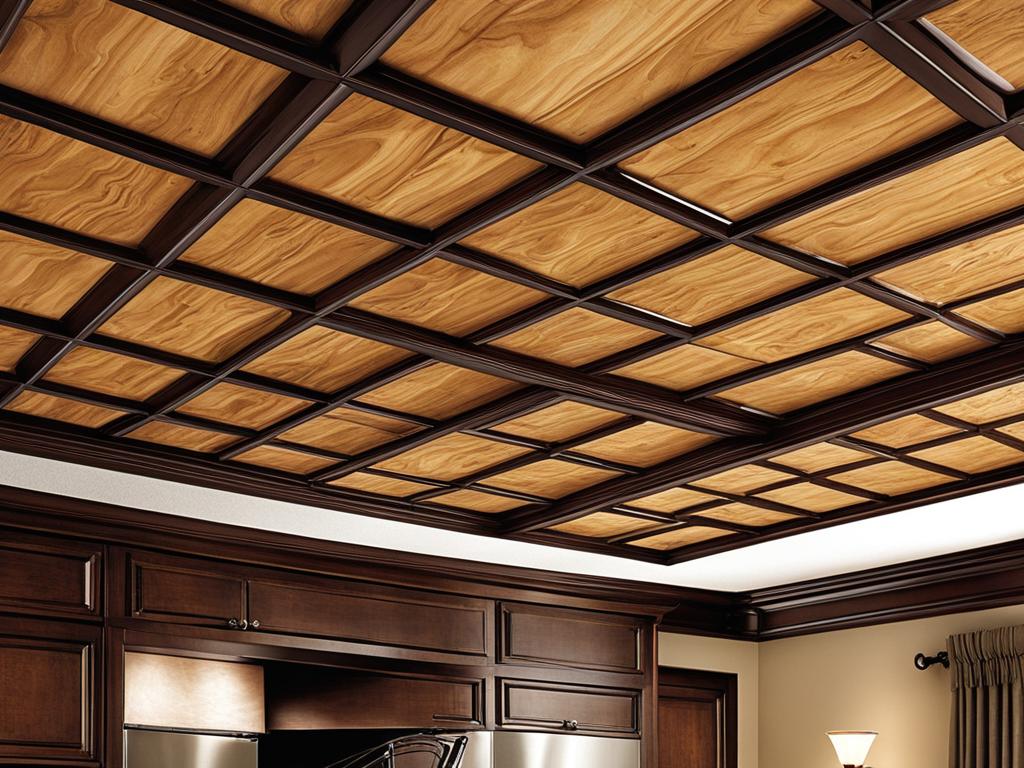 |
With these various design options, you can create a stunning and unique mobile home ceiling that reflects your personal style and transforms your living space.
Finding Replacement Mobile Home Gypsum Ceiling Panels
Finding exact replacement gypsum ceiling panels for older mobile homes can be a challenging task. These panels are often not readily available, and even if they are, there is no guarantee that they will match the exact texture of the original panels. However, there are a few options that homeowners can explore to address this issue.
One option is to check with local mobile home supply stores as they may carry gypsum ceiling panels. It is advisable to contact them directly to inquire about the availability of the desired panels. They can provide information on whether they have the specific panels in stock, or if they can order them for you.
Alternatively, if finding exact replacement panels proves to be difficult, homeowners can consider using alternative materials for their ceiling replacements. Two popular options are insulated mobile home ceiling panels and mobile home ceiling tiles.
Insulated mobile home ceiling panels are a great choice for those looking to improve the energy efficiency of their mobile homes. These panels are designed to provide insulation, helping to keep the interior comfortable and reducing heating and cooling costs.
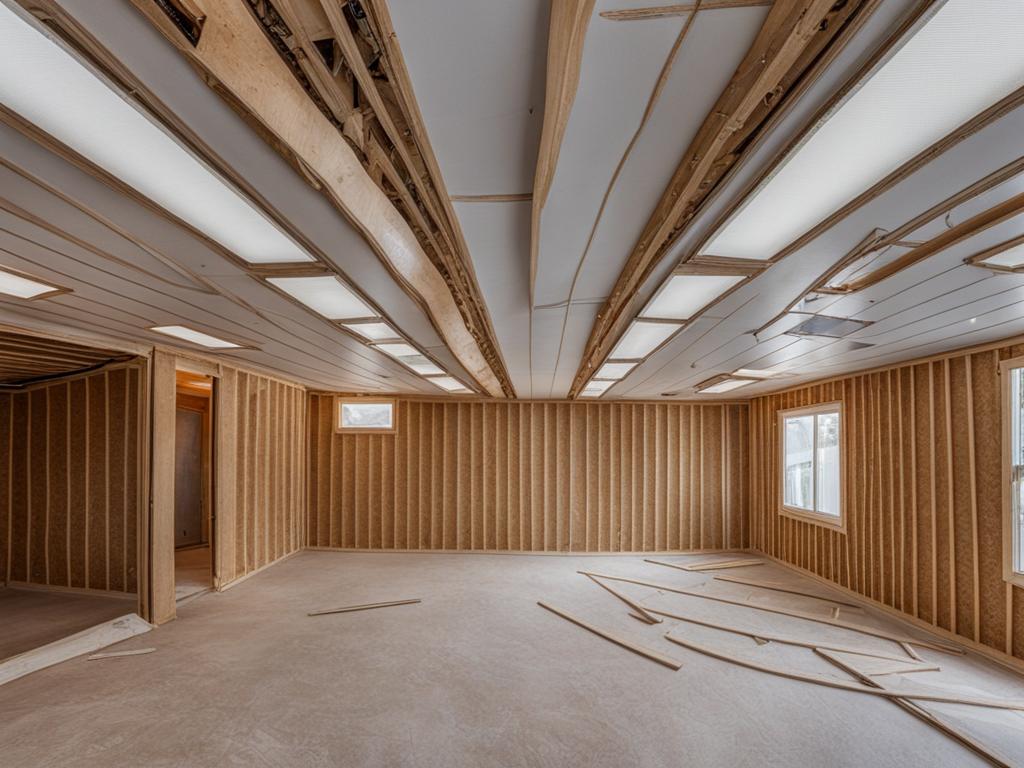
Another option to consider is mobile home ceiling tiles. These tiles are versatile and come in various designs and patterns, allowing homeowners to achieve the desired aesthetic for their mobile home interiors. They are easy to install and can be a cost-effective alternative to gypsum ceiling panels.
When choosing replacement materials, it is important to take into account factors such as durability, ease of installation, and maintenance requirements. It is also recommended to consult with professionals or seek guidance from mobile home supply stores for specific recommendations and installation techniques.
The Benefits of Insulated Mobile Home Ceiling Panels:
- Improved energy efficiency
- Reduced heating and cooling costs
- Enhanced comfort and insulation
- Easy installation process
- Various design options available
In conclusion, finding exact replacement gypsum ceiling panels for older mobile homes can be challenging, but there are alternative options to consider. Insulated mobile home ceiling panels and mobile home ceiling tiles can provide homeowners with functional and aesthetically pleasing solutions. It is important to explore all available options and select the materials that best meet the specific needs and preferences of your mobile home.
Installation Tips for Mobile Home Ceiling Panels
Installing mobile home ceiling panels requires careful handling and support to prevent damage. To ensure a successful installation, follow these tips:
Gather Necessary Materials
Before starting the installation process, gather the following materials:
- Mobile home ceiling panels
- Roofing nails or screws
- Hammer or screwdriver
- Level
- Tape measure
- Panel adhesive (if required)
Buy Extra Panels
To prepare for any mistakes or errors during the installation, it is recommended to purchase additional ceiling panels. This way, you’ll have spare panels to replace any damaged or incorrectly installed ones.
Follow Manufacturer’s Instructions
Each manufacturer may have specific installation instructions for their mobile home ceiling panels. It is crucial to carefully read and follow these instructions to ensure proper installation. Deviating from the guidelines provided may result in unstable or unsightly ceilings.
Secure Panels and Cover Seams
Depending on the chosen ceiling panel design, different installation methods may be required. Here are some common techniques:
- Use rosette washers: These washer-shaped accessories can be installed to reinforce the attachment of the ceiling panels to the underlying structure.
- Apply plastic trim: Installing plastic trim along the seams of the ceiling panels helps create a clean, finished look.
- Utilize battens or splines: These can be used to cover and hide the seams between ceiling panels. They provide extra support and enhance the overall appearance of the ceiling.
Consider Professional Help
If you are unsure about the installation process or want to ensure a flawless finish, it is advisable to seek professional help. Professional installers have the expertise and experience to handle mobile home ceiling panel installations efficiently and effectively.
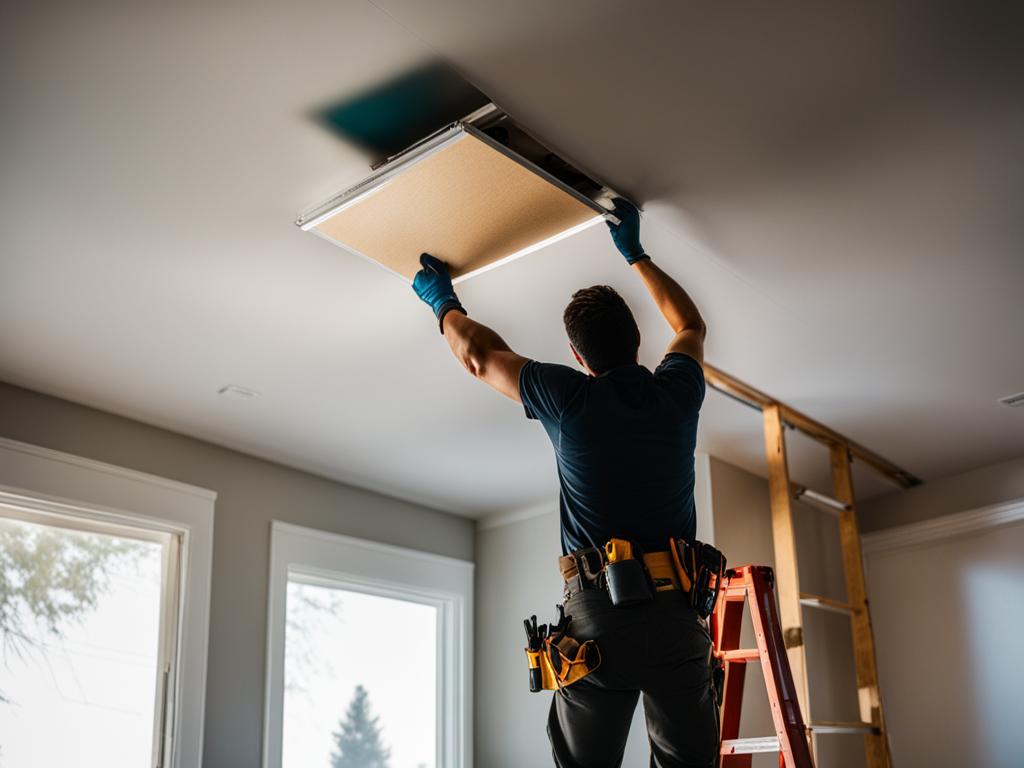
Repairing and Maintaining Mobile Home Ceiling Panels
Mobile home ceiling panels are prone to damage and sagging over time. However, with proper repair and maintenance techniques, you can ensure the longevity of your mobile home’s ceiling. Minor issues can often be resolved easily, while more severe damage may require complete panel replacement. Additionally, regular maintenance practices can help prevent future issues and extend the lifespan of your ceiling panels.
1. Correcting Minor Sagging
Sometimes, mobile home ceiling panels may develop minor sagging, which can be corrected with a simple repair technique. Follow these steps to fix minor sagging:
- Identify the sagging area on the ceiling panel.
- Using a spray bottle, wet the affected area with water.
- Gently push the wet area back into place, applying light pressure.
- Allow the panel to dry completely, ensuring it maintains its corrected shape.
This method is effective for minor sagging issues, but for significant damage or extensive sagging, further repair or replacement may be necessary.
2. Repairing Severe Damage
If your mobile home ceiling panels have suffered severe damage, such as significant sagging, cracks, or holes, it may be necessary to replace the damaged panels entirely. Follow these steps for repairing severe damage:
- Identify the damaged panels that require replacement.
- Remove the damaged panels carefully, ensuring not to cause further damage to the surrounding areas.
- Measure the dimensions of the replacement panels needed.
- Acquire new ceiling panels that match the material and dimensions of the original panels.
- Install the new panels according to the manufacturer’s instructions, ensuring proper attachment and alignment.
By replacing severely damaged panels, you can restore the structural integrity and appearance of your mobile home ceiling.
3. Regular Maintenance Practices
To keep your mobile home ceiling panels in good condition, it is essential to perform regular maintenance tasks. Follow these maintenance practices:
- Clean the ceiling panels regularly using a soft cloth or a duster to remove dust and debris.
- Avoid using harsh chemicals or abrasive cleaning agents that may damage or discolor the panels.
- Inspect the ceiling regularly for signs of water damage, leaks, or mold growth.
- Address any water leaks or excessive moisture issues promptly to prevent damage to the ceiling panels.
By implementing these maintenance practices, you can increase the lifespan of your mobile home ceiling panels and ensure they remain in optimal condition.
4. Visual Representation of Repair and Maintenance Techniques
“A picture is worth a thousand words.” In this case, a visual representation of the repair and maintenance techniques for mobile home ceiling panels can be highly beneficial. The image below illustrates the steps involved in fixing minor sagging and replacing severely damaged panels.”
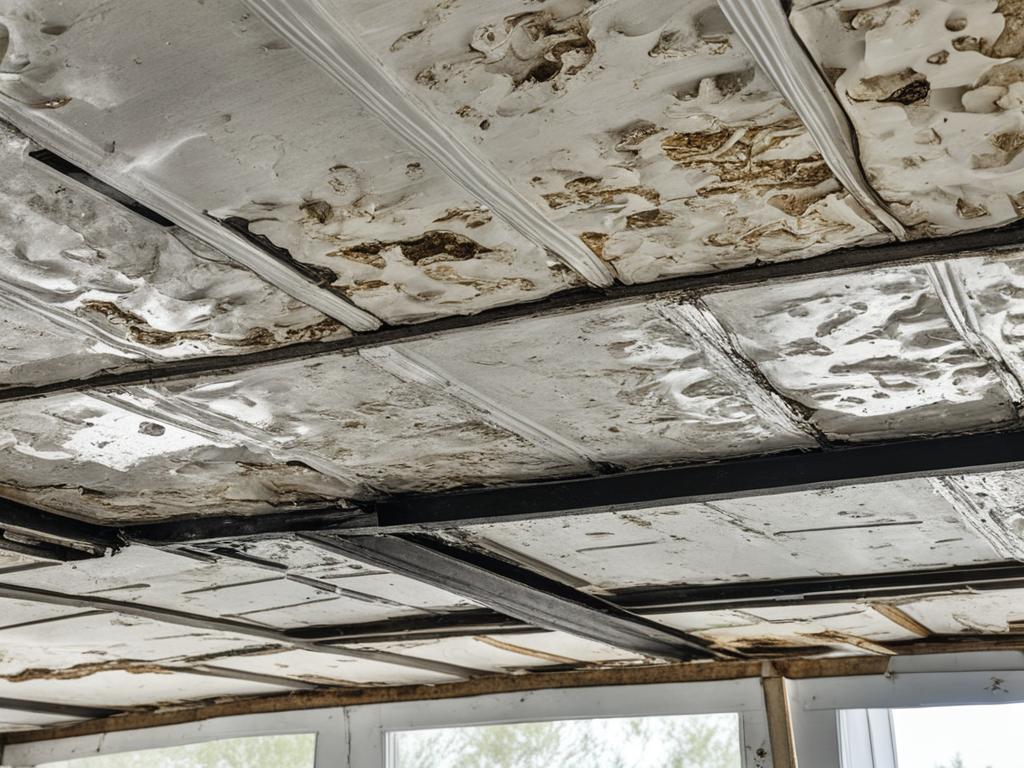
| Mobile Home Ceiling Repair Techniques | Steps |
|---|---|
| Correcting Minor Sagging | 1. Identify the sagging area on the ceiling panel. 2. Wet the affected area with water. 3. Gently push the wet area back into place. 4. Allow the panel to dry completely. |
| Repairing Severe Damage | 1. Identify and remove damaged panels. 2. Measure and acquire replacement panels. 3. Install new panels according to instructions. |
| Regular Maintenance Practices | 1. Clean the ceiling panels regularly. 2. Avoid using harsh chemicals or abrasive cleaners. 3. Inspect for water damage, leaks, or mold growth. 4. Address water leaks or excessive moisture issues promptly. |
By following these repair and maintenance techniques, you can ensure the durability and aesthetics of your mobile home’s ceiling panels. Regular upkeep and timely repairs will help you maintain a beautiful and functional mobile home interior.
Alternative Ceiling Options for Mobile Homes
If finding replacement gypsum ceiling panels becomes challenging, mobile homeowners have alternative options for ceiling replacements. These options not only offer solutions for damaged or hard-to-find panels but also provide an opportunity to give mobile homes a modern and updated look. Let’s explore some of the popular alternative ceiling options:
1. Lightweight Sheetrock
One popular option for mobile home ceilings is using lightweight sheetrock. Sheetrock is a type of drywall that can be easily hung on furring strips or joists. It is a cost-effective and durable alternative to traditional gypsum panels. Lightweight sheetrock offers a smooth and clean finish, providing a blank canvas for homeowners to paint or texture according to their preference.
2. Suspended Ceilings
Suspended ceilings, also known as drop ceilings, are another common choice for mobile homes. This type of ceiling consists of a metal grid system that holds acoustical tiles in place. Suspended ceilings offer a variety of design options, including different tile materials, patterns, and colors. They provide easy access to the space above the ceiling for maintenance or repairs.
Here’s an example of how a suspended ceiling can transform the look of a mobile home interior:
| Before | After |
|---|---|
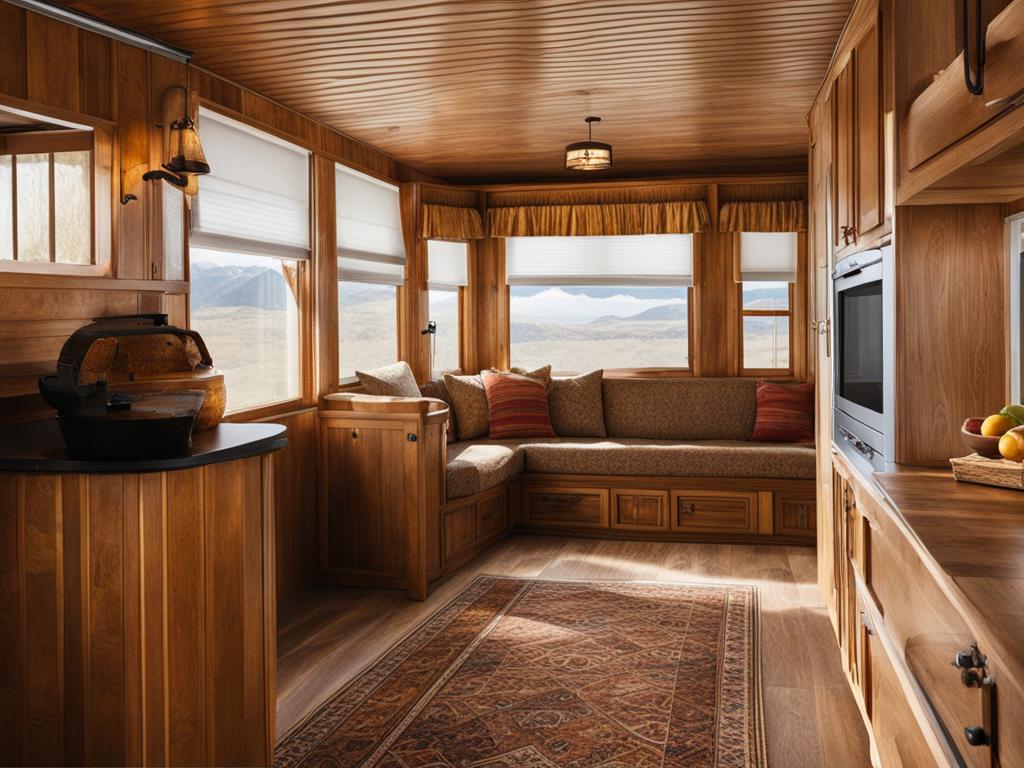 |
 |
3. Acoustical Tiles
Mobile homeowners can also consider using acoustical tiles as an alternative ceiling option. These tiles are specifically designed to absorb sound and improve acoustics in a room. Acoustical tiles come in a wide range of styles, textures, and colors, allowing homeowners to create a unique and visually appealing ceiling design. They are lightweight and easy to install, making them a convenient choice for mobile home renovations.
“The alternative ceiling options mentioned above provide mobile homeowners with flexibility and creativity in transforming the look and feel of their homes. Whether it’s lightweight sheetrock, suspended ceilings, or acoustical tiles, these alternatives offer aesthetic appeal, durability, and ease of installation.”
It’s important for mobile homeowners to consider their personal preferences, budget, and installation requirements when choosing an alternative ceiling option. Consulting with professionals or visiting local home improvement stores can provide valuable insights and recommendations based on the specific needs of the mobile home.
Considerations for Ceiling Replacement in Mobile Homes
Before embarking on a ceiling replacement project in your mobile home, it is important to take several factors into consideration. By carefully evaluating these aspects, you can ensure a successful and efficient ceiling replacement that meets your needs and preferences. Here are three key considerations to keep in mind:
1. Structural Integrity
The first step is to assess the structural integrity of your mobile home. Ensure that any modifications or additions to the ceiling will not compromise the stability of the overall structure. Consult with a professional contractor or engineer to determine if your home can support the weight of the new ceiling materials and any additional fixtures or features you plan to install. It’s essential to prioritize safety and ensure that your ceiling replacement does not pose any risks to the structural integrity of the mobile home.
2. Weight and Dimensions
Consider the weight and dimensions of the new ceiling materials you choose. Mobile homes are built with specific weight limitations and structural requirements, so it is essential to select materials that are suitable for your mobile home’s construction. Opt for lightweight materials that will not strain the existing framework. Additionally, make sure the dimensions of the new ceiling panels or tiles align with the measurements of your mobile home’s interior. Taking accurate measurements and carefully considering the weight and dimensions of the materials will help you avoid any complications during the installation process.
3. Professional Guidance
Although many homeowners choose to undertake DIY projects, seeking professional guidance for mobile home ceiling replacements is highly recommended. Mobile home supply stores and specialized contractors have extensive knowledge and experience working with mobile homes. They can provide specific recommendations for ceiling materials, installation techniques, and any additional considerations unique to mobile home structures. Getting professional guidance will ensure that your ceiling replacement project is executed seamlessly, meeting all safety and quality standards.
| Considerations for Ceiling Replacement in Mobile Homes |
|---|
| 1. Structural Integrity |
| 2. Weight and Dimensions |
| 3. Professional Guidance |
By carefully evaluating these considerations, you can confidently proceed with your mobile home ceiling replacement project. Prioritizing structural integrity, choosing appropriate materials, and seeking professional guidance will contribute to a successful and aesthetically pleasing outcome. Remember, a well-planned and executed ceiling replacement can transform the interior of your mobile home, enhancing its overall beauty and value.
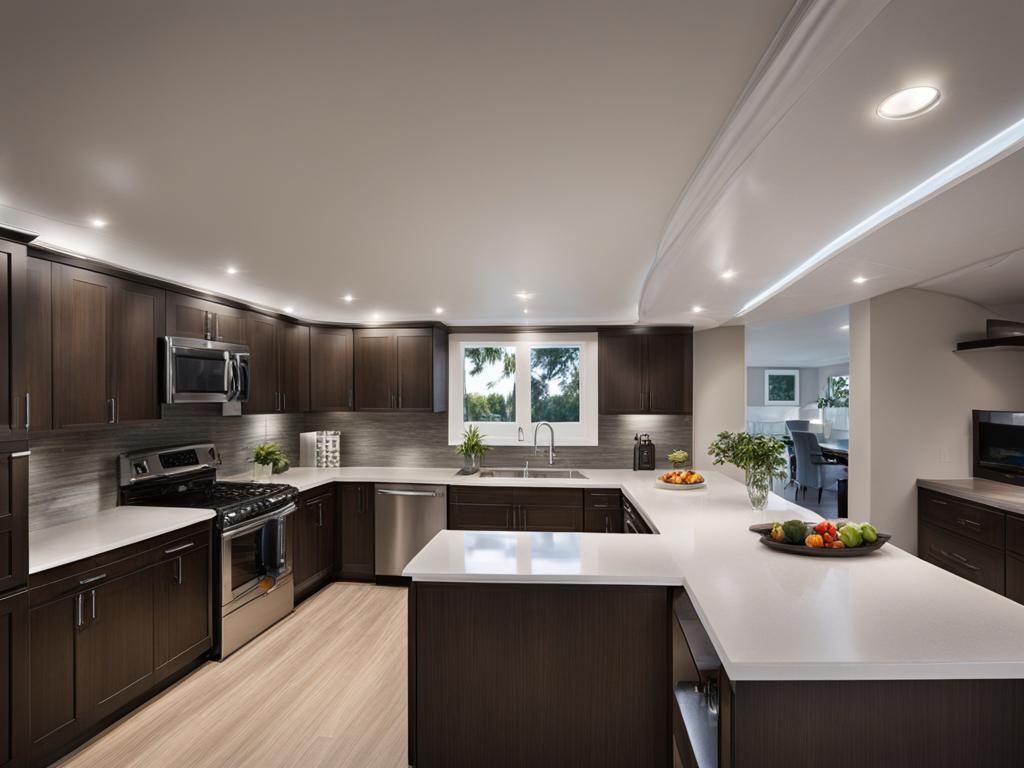
Cost and Accessibility of Mobile Home Ceiling Panels
When considering mobile home ceiling options or mobile home ceiling repair, it’s essential to factor in the cost and accessibility of ceiling panels. The price of mobile home ceiling panels can vary depending on factors such as size, thickness, and brand. Additionally, finding exact replacement panels for older mobile homes can sometimes be challenging and costly.
To get accurate information on the cost and availability of ceiling panels for mobile homes, it is recommended to reach out to local mobile home supply stores or explore online suppliers. They can provide valuable insights and help you make informed decisions about the right options for your mobile home. Working with trusted suppliers ensures you have access to a range of choices and can find the best fit for your budget and needs.
Conclusion
Mobile home ceiling panels are an integral part of any mobile home’s interior design. With a wide range of options available, homeowners have the opportunity to choose the best ceiling materials that not only enhance the aesthetics but also provide durability and functionality. By considering factors such as structural integrity, weight, and aesthetics, homeowners can make informed decisions on ceiling replacements or repairs.
Understanding the different designs and installation techniques is essential for a successful renovation project. Mobile home gypsum ceiling panels offer affordability, lightweight, and easy maintenance. However, if finding exact replacements is challenging, alternative options such as lightweight sheetrock or suspended ceilings with acoustical tiles provide modern solutions.
Whether replacing or repairing mobile home ceiling panels, it is crucial to prioritize the long-term durability and visual appeal. Consulting with professionals and contacting local mobile home supply stores can ensure access to the right materials and expert advice for a successful project. By taking these considerations into account, homeowners can create a beautiful and functional mobile home interior that reflects their personal style.
FAQ
What are mobile home ceiling panels made of?
Mobile home ceiling panels are typically made of gypsum panels.
What are the advantages of mobile home gypsum ceiling panels?
Mobile home gypsum ceiling panels are affordable, lightweight, and easy to replace or repair if damaged.
What are the different designs available for mobile home gypsum ceiling panels?
Mobile home gypsum ceiling panels can be designed with rosettes, plastic trim, beaded profiles, splines, channeled ceiling dividers, integrated strips, dimensional beams, or false beams.
What should I do if I need to find replacement mobile home gypsum ceiling panels?
Contact local mobile home supply stores or consider using alternative materials such as insulated panels or sheetrock for ceiling replacements.
What are some tips for installing mobile home ceiling panels?
Carefully handle and support the panels, follow the manufacturer’s instructions, and consider seeking professional help if unsure about the installation process.
How can I repair and maintain mobile home ceiling panels?
Minor sagging can sometimes be corrected by pushing it back into place, while severe sagging or damage may require more extensive repairs or replacing the damaged panels. Regular cleaning and avoiding excessive moisture can help extend the lifespan of the panels.
What are some alternative ceiling options for mobile homes?
Alternative options for mobile home ceilings include lightweight sheetrock, suspended ceilings with acoustical tiles, or drop ceilings.
What considerations should I keep in mind for ceiling replacement in mobile homes?
Check the structural integrity of the home, consider the weight and dimensions of the new materials, and seek guidance from professionals or mobile home supply stores for specific recommendations.
How much do mobile home ceiling panels cost, and how accessible are they?
The cost and accessibility of mobile home ceiling panels can vary. It is best to contact local mobile home supply stores or online suppliers for accurate information.
What should I know about mobile home ceiling panels?
Mobile home ceiling panels are crucial for the overall appearance and functionality of a mobile home. Understanding their different designs, installation techniques, and alternative options can help homeowners make informed decisions for ceiling replacements or repairs.

